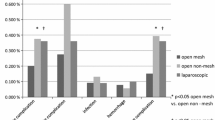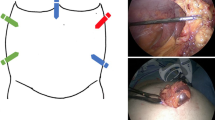Abstract
Background
The use of mesh has revolutionized the management of hernias in many parts of the world. There is, however, limited experience on its use in sub-Saharan Africa. This study describes a single hospital experience after 500 cases of mesh hernia repairs in a sub-Saharan African country.
Methods
We reviewed the records of the first 500 cases of abdominal wall hernia operations performed using commercial mesh since year 2007. Socio-demographic characteristics, hernia type, method of repair and outcome data were analyzed and presented as descriptive statistics.
Results
The first 500 cases of mesh hernia repairs were performed between 2007 and 2017 during which a total of 1,175 hernia operations were carried out, mesh repair accounting for 42.5% of the total. There was a progressive rise in the uptake of mesh repairs over time, with mesh repairs overtaking tissue based repairs in the last few years of the review. Inguinal hernia was by far the commonest indication for mesh use (80.4%), followed by incisional hernia (9%). Polypropylene mesh was the most common type of mesh used in about 96.2% of cases. Overall, there were seven recurrences (1.4%) at a mean follow-up period of 15.3 months (1–108 months)
Conclusion
In spite of resource limitations, the use of mesh for hernia repairs continues to rise and has overtaken tissue-based repairs in a sub-Saharan African setting. Results show good outcomes justifying continued use.


Similar content being viewed by others
References
Usher FC, Ochsner J, Tuttle LL Jr (1958) Use of marlex mesh in the repair of incisional hernias. Am Surg 24(12):969–974
Brown CN, Finch JG (2010) Which mesh for hernia repair? Ann R Coll Surg Engl 92(4):272–278
Ismaila BO, Alayande BT, Ojo EO, Sule AZ (2019) Inguinal hernia repair in Nigeria: a survey of surgical trainees. Hernia. https://doi.org/10.1007/s10029-019-01885-0
Tabiri S, Yenli EMT, Gyamfi FE, Jalali A, Nelson RE, Price RR et al (2018) The use of mesh for inguinal hernia repair in northern Ghana. J Surg Res 230:137–142
Rouet J, Bwelle G, Cauchy F, Masso-Misse P, Gaujoux S, Dousset B (2018) Polyester mosquito net mesh for inguinal hernia repair: a feasible option in resource limited settings in Cameroon? J Visc Surg 155(2):111–116
Patterson T, Currie P, Patterson S, Patterson P, Meek C, McMaster R (2017) A systematic review and meta-analysis of the post-operative adverse effects associated with mosquito net mesh in comparison to commercial hernia mesh for inguinal hernia repair in low income countries. Hernia 21(3):397–405
Olasehinde O, Lawal OO, Agbakwuru EA, Adisa AO, Alatise OI, Arowolo OA et al (2016) Comparing Lichtenstein with darning for inguinal hernia repair in an African population. Hernia 20(5):667–674
Udo IA, Bassey EA, Abasiattai AM (2014) Early outcome of incisional hernia repair using polypropylene mesh: a preliminary report. Niger Med J 55(4):333–337
Gil J, Rodriguez JM, Gil E, Hernandez Aguera Q, Gonzalez FM, Garcia JA et al (2015) The usefulness of international cooperation in the repair of inguinal hernias in Sub-Saharan Africa. World J Surg 39(11):2622–2629
Arowolo OA, Agbakwuru EA, Adisa AO, Lawal OO, Ibrahim MH, Afolabi AI (2011) Evaluation of tension-free mesh inguinal hernia repair in Nigeria: a preliminary report. West Afr J Med 30(2):110–113
Forrester JD, Forrester JA, Yang GP (2016) Surgical mesh should be made affordable to low-and middle-income countries. JAMA Surg 151(6):499–500
Bilsel Y, Abci I (2012) The search for ideal hernia repair; mesh materials and types. Int J Surg (London, England) 10(6):317–321
Lak KL, Goldblatt MI (2018) Mesh selection in abdominal wall reconstruction. Plast Reconstr Surg 142(3 Suppl):99s–106s
Ekwunife CN, Nwobe O (2014) First 100 laparoscopic surgeries in a predominantly rural Nigerian population: a template for future growth. World J Surg 38(11):2813–2817
Adisa AO, Lawal OO, Arowolo OA, Alatise OI (2013) Local adaptations aid establishment of laparoscopic surgery in a semiurban Nigerian hospital. Surg Endosc 27(2):390–393
Amid PK, Shulman AG, Lichtenstein IL (1996) Open "tension-free" repair of inguinal hernias: the Lichtenstein technique. Eur J Surg 162(6):447–453
Gopal SV, Warrier A (2013) Recurrence after groin hernia repair-revisited. Int J Surg (London, England) 11(5):374–377
Lofgren J, Beard J, Ashley T (2018) Groin hernia surgery in low-resource settings—a problem still unsolved. N Engl J Med 378(14):1357–1358
Author information
Authors and Affiliations
Corresponding author
Ethics declarations
Conflict of interest
The authors declare no conflict of interest.
Ethical approval
Ethical approval was obtained for the study.
Human and animal rights
There was no violation of human and animal rights.
Informed consent
Informed consent was obtained.
Rights and permissions
About this article
Cite this article
Agbakwuru, E.A., Olasehinde, O., Onyeze, C.I. et al. Use of commercial mesh for hernia repair in a low resource setting: experience after 500 cases. Hernia 24, 613–616 (2020). https://doi.org/10.1007/s10029-019-01987-9
Received:
Accepted:
Published:
Issue Date:
DOI: https://doi.org/10.1007/s10029-019-01987-9




